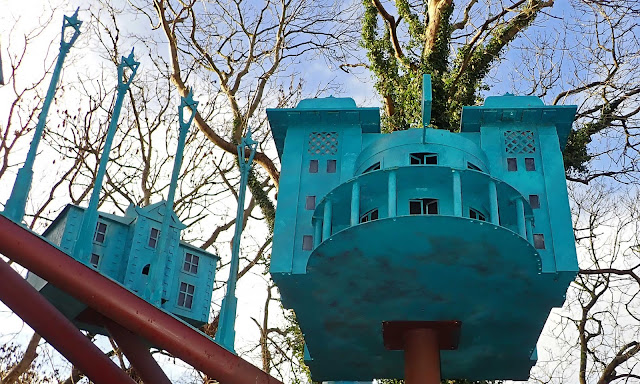I’m several months late to the party but today I’d like to celebrate the fact that this year Penarth has gained a new public artwork, and, though I think it fails in its aspirations, I rather like the piece itself.
You might, justifiably, wonder how the Vale of Glamorgan Council managed to fund something like this given the financial challenges of the current global pandemic. In fact, this was part of the development deal, the obligations negotiated under the Section 106 agreement, when Council granted planning permission for the Penarth Heights housing development.
The Skytown Gateway sits above the central entrance to Dingle Park, on Windsor Road in Penarth. According to the Council’s website, the park’s ‘entrances and boundary railings were considered to be unsightly’ so were ‘identified as requiring an upgrade in order to provide a visually impressive, exciting and high quality gateway into the town.’ A well-meaning sentiment perhaps, and the railings do look much better since they’ve been refurbished, but neither the lower nor upper entrances to the park have changed at all and they are, in fact, the entrances that get most use. And, though I do think the gateway artwork is impressive, its effect as a town rather than a park gateway is lost by its position immediately adjacent to a roundabout, which drivers of passing traffic are, hopefully, concentrating on negotiating rather than glancing around at the scenery. Also, as there is nowhere nearby to park, visitors to the town are unlikely to stop to admire the artwork, so as a ‘gateway into the town’, it fails.
As a ‘visually impressive’ gateway, though, I think it’s a winner, and the makers, a company called Cod Steaks from Bristol, have done a great job of capturing the character of the town. The Council website page about the Skytown Gateway project includes a link to a report from Cod Steaks on their creation process, including consultations with the local community and workshops with local school children to develop the ideas behind the finished artwork. It’s interesting to note that their workshops initially focused on the local flora and fauna, as you might expect from a gateway to a park, but the end product refers only to the built heritage of the town with no reference at all to the natural environment, a missed opportunity but presumably a deliberate decision by the Council.
As you can see in my photographs, the gateway includes references to many well-known local buildings and to the town’s maritime history. Residents will recognise St Augustine’s Church, the Penarth Pier Pavilion, the former public swimming baths, and the old Custom House, as well as generic terraced houses and a town house, the town clock and the lamp standards that run along the Esplanade. From the surrounding maritime landscape, there are the lighthouse on the island of Flat Holm and the Pink Shed, formerly used for yachting race officials, that sits on an arm of the Cardiff Barrage, and a tug boat. And representing local tourism and recreational facilities, the artwork includes a yacht and a caravan.
The Cod Steaks project report notes that the artwork has been constructed from over 4000 pieces of precision-cut steel, finished with blue paint, and includes low-level LED lighting within the buildings, which must look quite lovely at night – I have yet to visit in the evenings so have no visuals of the ‘diffused, charming glow’ of the lighting effects. When I do get some photos, I’ll add one or two to this post.


























































